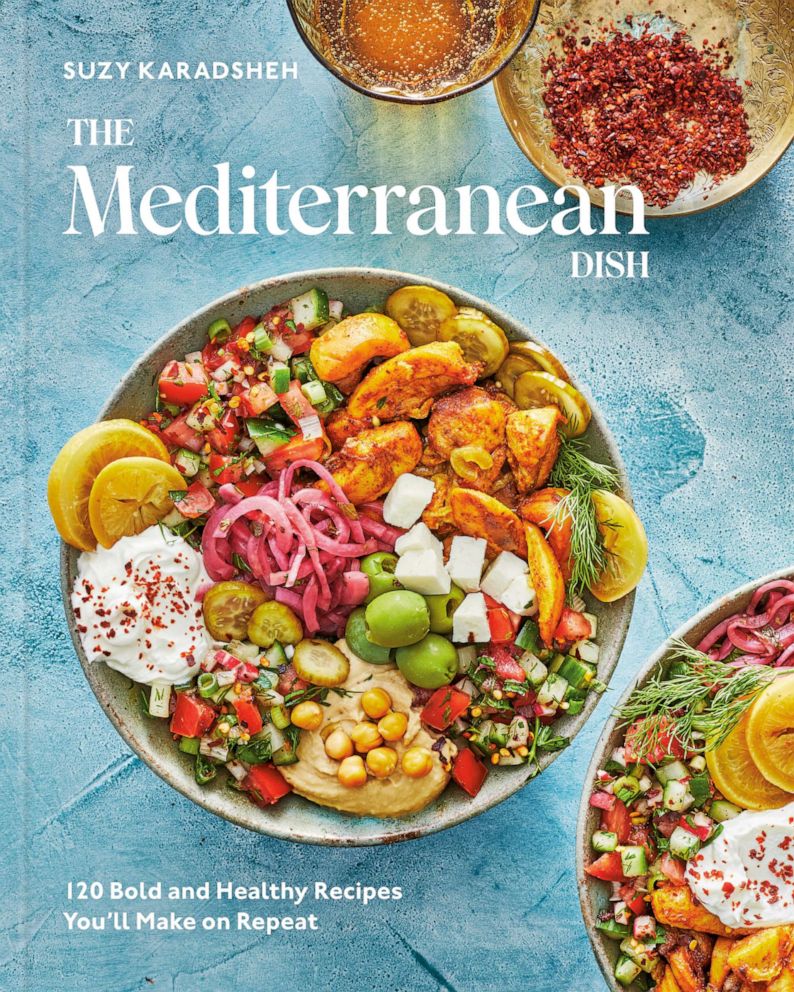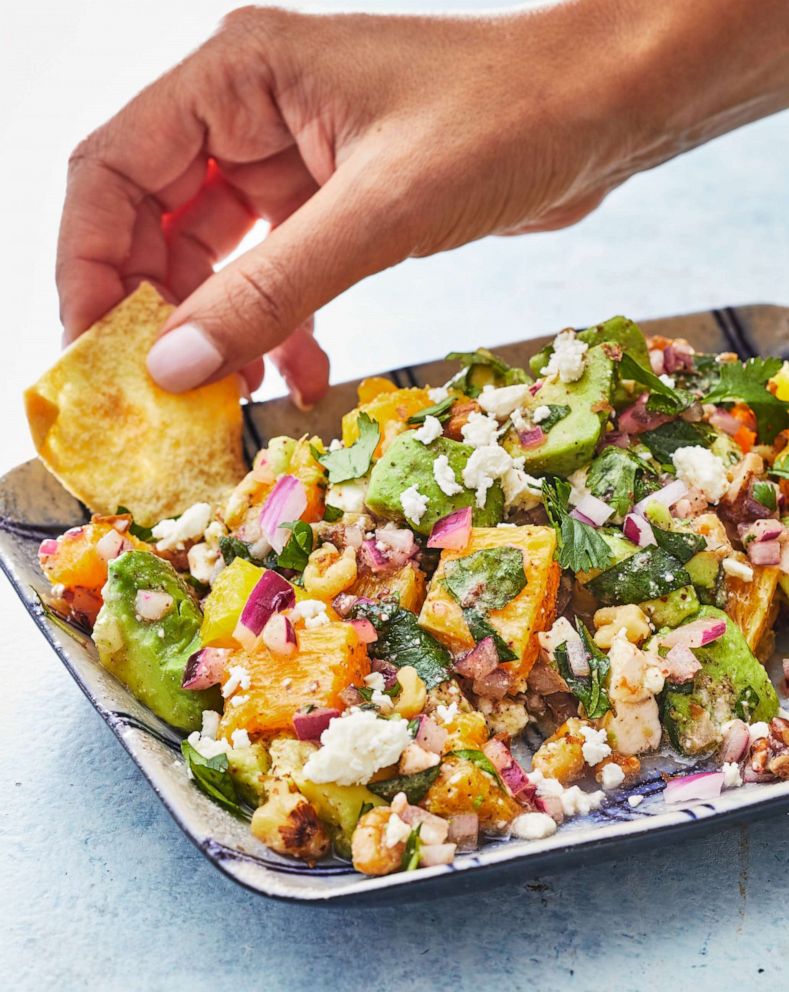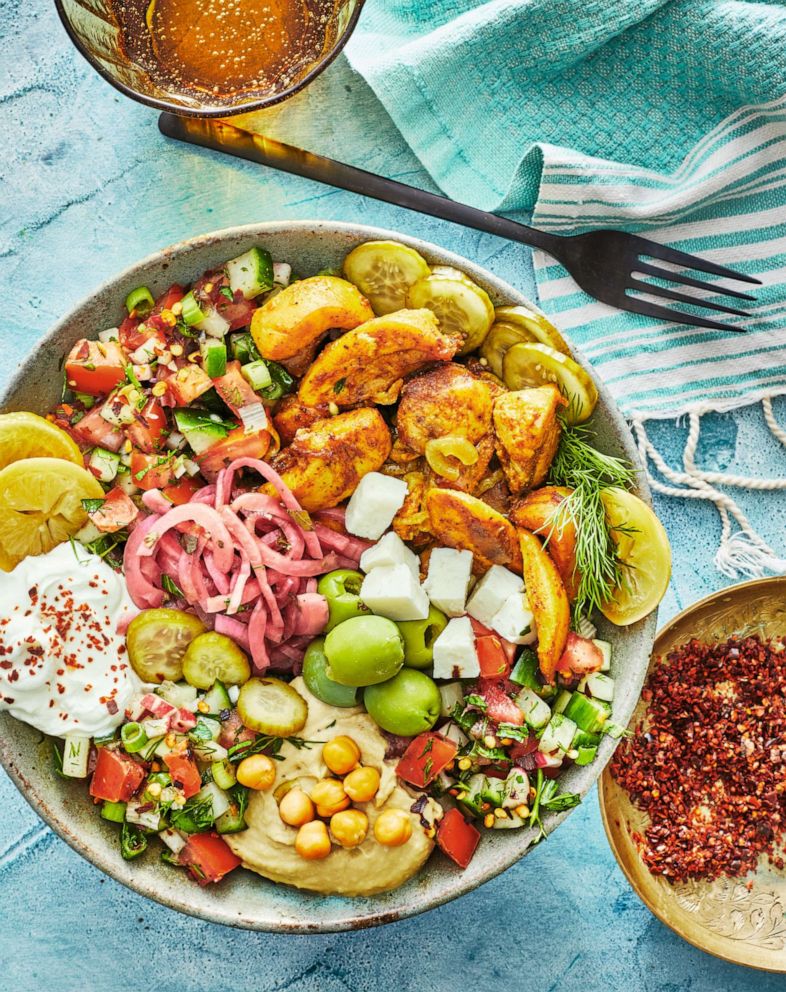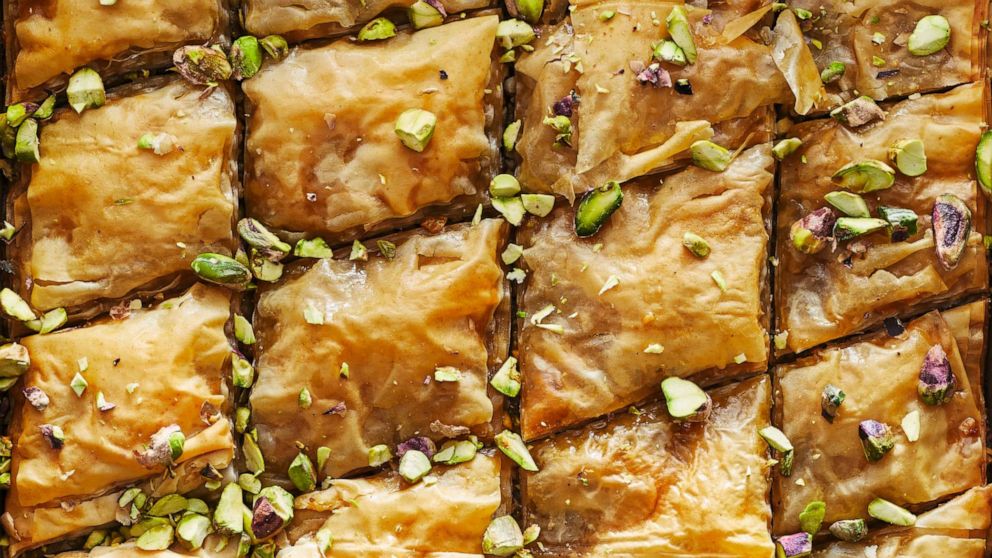From hit food website to first-time cookbook, “The Mediterranean Dish” offers an array of bright, flavorful recipes to bring the culture of Mediterranean cuisine to home kitchens with ease.
Creator and author Suzy Karadsheh joined “Good Morning America” to offer a handful of her favorite recipes that live up to the title of her debut book: “120 Bold and Healthy Recipes You’ll Make on Repeat.”
Karadsheh, who was born and raised in Port Said, Egypt, lives in Atlanta and has developed a large online presence as a culinary creator.
Her cookbook includes recipes that range from mezze and small plates to mashup brunch dishes like za’atar sweet potato and chickpea breakfast hash.
Check out three of her full recipes below.
Citrus-avocado dip with walnuts, feta and herbs
Makes: Approximately 2 large cups, serves 6
2 navel oranges, peeled and diced
2 large avocados (or 3 smaller), pitted, peeled, and diced
1/2 cup finely chopped red onion
1/2 cup finely chopped fresh cilantro
1/2 cup finely chopped fresh mint leaves
1/2 cup coarsely chopped walnuts, toasted
Kosher salt and ground black pepper
Juice of 1 large lime (about 2 tablespoons)
1 to 2 ounces Greek feta cheese, crumbled (1/4 to 1/2 cup)
Chips or crostini, for serving
Place the oranges, avocado, red onion, cilantro, mint and walnuts in a large bowl. Season with salt and pepper (about half a teaspoon each), the sumac and cayenne.
Add the lime juice and 2 tablespoons of the olive oil. Toss gently to combine. Top with the feta and serve with chips or crostini.
Chicken shawarma bowls
Shawarma Seasoning
2 1/4 teaspoons ground coriander
2 1/4 teaspoons ground cumin
2 1/4 teaspoons garlic powder
2 1/4 teaspoons sweet paprika
2 1/4 teaspoons ground turmeric
1 1/2 teaspoons ground cloves
1/2 teaspoon cayenne pepper, or more to your liking
For the chicken
8 boneless, skinless chicken thighs
Kosher salt
1 large onion, thinly sliced
Juice of 1 large lemon (about ¼ cup)
1/8 cup extra-virgin olive oil, plus more for pan
In a small bowl, mix the coriander, cumin, garlic powder, paprika, turmeric, cloves and cayenne.
Pat the chicken thighs dry and thinly slice into bite-sized pieces. In a large bowl, add the chicken, the shawarma seasoning and about 1 teaspoon salt. Toss to coat. Add the onion, lemon juice, and 1/8 cup olive oil. Toss again. Cover and refrigerate for 2 hours or overnight. (If you don’t have time, let the chicken marinate at room temperature for up to 30 minutes.)
Position one rack in the center of the oven and another one 4 or 5 inches under the broiler. Preheat the oven to 425 degrees. Brush a 13-by-18-by-1 sheet pan with olive oil.
Spread the chicken and onion in a single layer on the sheet pan. Roast on the middle rack until the thickest piece is cooked through, 20 to 30 minutes. For a more browned, crispier chicken, move the pan to the top rack and broil a minute or two, watching very carefully to avoid burning.
Prepare to serve: While the chicken is roasting, set out the salads, hummus or tzatziki, and anything else you’re using in your shawarma bowls.
When ready to serve, divide the cooked chicken shawarma among 4 to 6 dinner bowls. Add the salad, dip and pickles. Serve immediately.
Triple nutty baklava
Makes 24 pieces, serves 12
“Iconic baklava (or baklawa) needs no big introduction. But when you grow up eating it at nearly every special gathering, you become a bit of a baklava snob, accepting nothing less than the best homemade stuff made with layers of appropriately honeyed, crisp phyllo sheets and just the right amount of nuts tucked in between,” Karadsheh said.
Traditionalists make baklava with either walnuts or pistachios, but I love mine extra nutty with a trio of nuts and a generous hint of cinnamon. Baklava is not hard to make, and if you know how to assemble a lasagna, you’ll find the soothing process of layering is pretty similar. I know it’s a bit of a labor of love, but I think it’s worth it. Plus, it’s the kind of dessert that’s even better the next day — great for making ahead of time for parties and holidays.
Honey syrup
3/4 cup sugar
1 cup cold water
1 cup honey
1 tablespoon orange extract
5 whole cloves
Juice of 1 large lemon
Baklava
6 ounces shelled pistachios, roasted and chopped (about 1¼ cups), plus extra for garnish
6 ounces walnuts, roasted and chopped (about 1¼ cups)
6 ounces hazelnuts, roasted and chopped (about 1¼ cups)
1/4 cup sugar
1 tablespoon ground cinnamon
1/4 teaspoon ground cloves
1 (1-pound) package phyllo dough, thawed if frozen
2 sticks (1 cup, 16 tablespoons) unsalted butter, melted
Make the honey syrup: Place the sugar and water in a medium saucepan set over medium-high heat and simmer until the sugar dissolves, about 1 minute, stirring occasionally. Stir in the honey, orange extract and whole cloves, then bring to a boil, turn the heat to medium-low and simmer about 25 minutes. Remove the saucepan from the heat and let the syrup cool, then stir in the lemon juice (the syrup should be sticky and not too runny).
Position a rack in the center of the oven. Preheat the oven to 350 degrees.
Make the baklava: In the bowl of a food processor fitted with the multipurpose blade, combine the pistachios, walnuts and hazelnuts. Pulse a few times to finely chop. Transfer to a large bowl and add the sugar, cinnamon (start with less if you’re not sure) and ground cloves. Mix well to combine.
Unroll the phyllo pastry and place the sheets on a clean kitchen towel, then cover the stack with a second clean kitchen towel.
Brush a 9-by-13-by-2 baking pan with some of the melted butter. Take one sheet of phyllo and place it in the pan (if the phyllo sheets are larger than your pan, feel free to fold them to fit or use kitchen shears to trim). Brush the top of the phyllo with more melted butter. Repeat this process a few more times, until you have used about one-third of the phyllo dough. Now, sprinkle half the nut mixture evenly over the top layer of phyllo. Continue adding sheets of phyllo and brushing each with melted butter until you have used about half of the remaining phyllo sheets. Distribute the remaining nut mixture evenly over the top of that second layer of phyllo. Finish with the remaining batch of phyllo, following the same process, and after adding the last sheet, brushing the top with melted butter.
Use a thin sharp or a serrated knife to cut the baklava in a gentle sawing motion on the diagonal in both directions so you have 24 to 36 diamond-shaped pieces.
Bake the baklava for 30 to 45 minutes, until the top turns a light golden brown and a skewer inserted in the center comes out clean. (Note: Because ovens vary, be sure to check your baklava halfway through baking.)
As soon as you remove the baklava from the oven, pour the cooled syrup all over it (it will make a sizzling sound). Set aside at room temperature for at least 1 hour before serving to make sure the syrup has been absorbed. Cut through the earlier marked pieces and serve with a garnish of chopped pistachios, if you like.
Store the baklava in the pan, covered with plastic wrap, at room temperature for the first night or two. To store leftovers for a longer period, transfer the baklava to airtight containers and leave in the fridge for a few days, or freeze for up to three months. Thaw the frozen baked baklava in the fridge overnight or at room temperature for a few hours before serving.
“The Mediterranean Dish” Copyright © 2022 by Suzy Karadsheh. Photographs copyright © 2022 by Caitlin Bensel. Published by Clarkson Potter, an imprint of Random House.”












